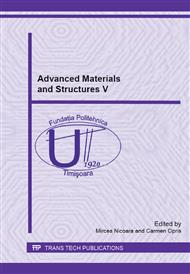[1]
T. Sadowski, S. Samborski, Development of damage state in porous ceramics under compression. Comput. Mat. Sci. 43 (2008) 75-81.
DOI: 10.1016/j.commatsci.2007.07.041
Google Scholar
[2]
T. Sadowski, L. Marsavina, Multiscale modelling of two-phase ceramic matrix composites Comput. Mat. Sci. 50 (2011) 1336-1346.
DOI: 10.1016/j.commatsci.2010.04.011
Google Scholar
[3]
T. Sadowski, Gradual degradation of two-phase ceramic composites under compression, Comput. Mat. Sci. 64 (2012) 209-211.
DOI: 10.1016/j.commatsci.2012.01.034
Google Scholar
[4]
T. Sadowski, S. Hardy, E. Postek, Prediction of the mechanical response of polycrystalline ceramics containing metallic inter-granular layers under uniaxial tension. Comput. Mat. Sci. 34 (2005) 46-63.
DOI: 10.1016/j.commatsci.2004.10.005
Google Scholar
[5]
T. Sadowski, S. Hardy, E. Postek, A new model for the time-dependent behaviour of polycrystalline ceramic materials with metallic inter-granular layers under tension. Mat. Sci. Eng. A 424 (2006) 230-238.
DOI: 10.1016/j.msea.2006.03.004
Google Scholar
[6]
T. Sadowski, E. Postek, C. Denis, Stress distribution due to discontinuities in polycrystalline ceramics containing metallic inter-granular layers. Comput. Mat. Sci. 39 (2007) 230-236.
DOI: 10.1016/j.commatsci.2006.03.022
Google Scholar
[7]
E. Postek, T. Sadowski, Assessing the Influence of Porosity in the Deformation of Metal-Ceramic Composites, Comp. Interfaces 18 (2011) 57-76.
DOI: 10.1163/092764410x554049
Google Scholar
[8]
T. Sadowski, T. Nowicki, Numerical investigation of local mechanical properties of WC/Co composite. Comput. Mat. Sci. 43 (2008) 235-241.
DOI: 10.1016/j.commatsci.2007.07.030
Google Scholar
[9]
T. Sadowski, A. Neubrand, Estimation of the crack length after thermal shock in FGM strip. Int. J. Fract. 127 (2004) 135-140.
DOI: 10.1023/b:frac.0000035087.34082.88
Google Scholar
[10]
T. Sadowski, K. Nakonieczny, Thermal shock response of FGM cylindrical plates with various grading patterns. Comput. Mat. Sci. 43 (2008) 171-178.
DOI: 10.1016/j.commatsci.2007.07.051
Google Scholar
[11]
K. Nakonieczny, T. Sadowski, Modelling of thermal shock in composite material using a meshfree FEM. Comp. Mater. Sci. 44 (2009) 1307-1311.
DOI: 10.1016/j.commatsci.2008.08.019
Google Scholar
[12]
T. Sadowski, S. Ataya, K. Nakonieczny, Thermal analysis of layered FGM cylindrical plates subjected to sudden cooling process at one side – comparison of two applied methods for problem solution. Comp. Mater. Sci. 45 (2009) 624-632.
DOI: 10.1016/j.commatsci.2008.07.011
Google Scholar
[13]
M. Birsan, H. Altenbach., T. Sadowski, V. Eremeyev, D. Pietras, Deformation analysis of functionally graded beams by the direct approach. Comp. Part B 43 (2012) 1315-1328.
DOI: 10.1016/j.compositesb.2011.09.003
Google Scholar
[14]
V. Burlayenko, T. Sadowski, Effective elastic properties of foam-filled honeycomb cores of sandwich panels. Comp. Struct. 92 (2010) 2890-2900.
DOI: 10.1016/j.compstruct.2010.04.015
Google Scholar
[15]
T. Sadowski, P. Golewski, Multidisciplinary analysis of the operational temperature increase of turbine blades in combustion engines by application of the ceramic thermal barrier coatings (TBC), Comput. Mat. Sci. 50 (2011) 1326-1335.
DOI: 10.1016/j.commatsci.2010.05.032
Google Scholar
[16]
T. Sadowski, P. Golewski, The influence of quantity and distribution of cooling channels of turbine elements on level of stresses in the protective layer TBC and the efficiency of cooling, Comput. Mat. Sci. 52 (2012) 293-297.
DOI: 10.1016/j.commatsci.2011.02.027
Google Scholar
[17]
T. Sadowski, P. Golewski, The Analysis of Heat Transfer and Thermal Stresses in Thermal Barier Coatings under Exploitation, Defect and Diffusion Forum 326-328 (2012) 530-535.
DOI: 10.4028/www.scientific.net/ddf.326-328.530
Google Scholar
[18]
T. Sadowski, P. Golewski, Detection and numerical analysis of the most efforted places in turbine blades under real working conditions, Comput. Mat. Sci. 64 (2012) 285 – 288.
DOI: 10.1016/j.commatsci.2012.02.048
Google Scholar
[19]
G. L. Golewski, T. Sadowski, P. Golewski, Numerical modeling crack propagation under Mode II fracture in plain concretes containing siliceous fly-ash additive using XFEM method, Comput. Mat. Sci. 62 (2012) 75-78.
DOI: 10.1016/j.commatsci.2012.05.009
Google Scholar
[20]
G. L. Golewski, T. Sadowski, Experimental investigation and numerical modeling fracture processes under Mode II in concrete composites containing fly-ash additive at early age, Solid State Phenomena 188 (2012) 158-163.
DOI: 10.4028/www.scientific.net/ssp.188.158
Google Scholar
[21]
Abaqus Documentation.
Google Scholar
[22]
W. G. Mao, C. Y. Dai, L. Yang, Y. C. Zhou, Interfacial fracture characteristic and crack propagation of thermal barrier coatings under tensile conditions at elevated temperatures, Int J Fract 151 (2008) 107–120.
DOI: 10.1007/s10704-008-9246-y
Google Scholar
[23]
Y. Yamazaki, A. Schmidt, A. Scholz, The determination of the delamination resistance in thermal barrier coating system by four-point bending tests, Surface & Coatings Technology 201 (2006) 744–754.
DOI: 10.1016/j.surfcoat.2005.12.023
Google Scholar
[24]
C. Pfeiffer, E. Affeldt, M. Göken, Miniaturized bend tests on partially stabilized EB-PVD ZrO2 thermal barrier coatings, Surface & Coatings Technology 205 (2011) 3245–3250.
DOI: 10.1016/j.surfcoat.2010.11.047
Google Scholar
[25]
H. Aleksanoglu, A. Scholz, M. Oechsner, C. Berger, M. Rudolphi, M. Schütze, W. Stamm, Determining a critical strain for APS thermal barrier coatings under sernice relevant loading conditions, Int. J. Fatigue 53 (2013) 40-48.
DOI: 10.1016/j.ijfatigue.2011.11.018
Google Scholar
[26]
L. Marsavina, T. Sadowski, Kinked crack at bi-material ceramic interface – numerical determination of fracture parameters, Comput. Mat. Sci. 44 (2009) 941-950.
DOI: 10.1016/j.commatsci.2008.07.005
Google Scholar
[27]
L. Marsavina, T. Sadowski, Fracture parameters at bi-material ceramic interfaces under bi-axial state of stress, Comput. Mat. Sci. 45 (2009) 693-697.
DOI: 10.1016/j.commatsci.2008.06.005
Google Scholar
[28]
L. Marsavina, T. Sadowski, Stress intensity factors for an interface kinked crack in a bi-material plate loaded normal to the interface. Int. J. Frac. 145 (2007) 237-243.
DOI: 10.1007/s10704-007-9124-z
Google Scholar
[29]
I. Ivanov, T. Sadowski, D. Pietras, Crack propagation in functionally graded strip under thermal shock. Eur. Phys. J. Special Topics 222 (2013) 1587-1595.
DOI: 10.1140/epjst/e2013-01947-3
Google Scholar


